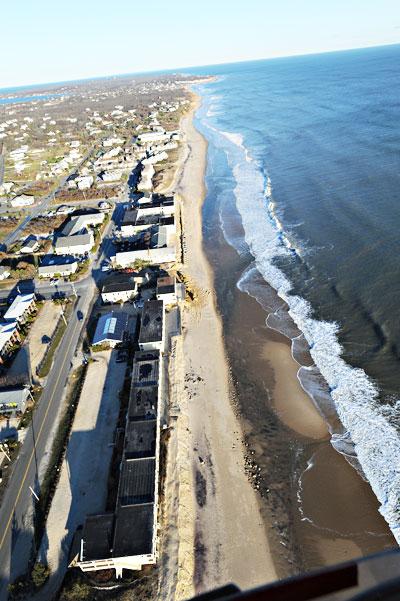What’s the Erosion Plan for Montauk?

Members of the Montauk Citizens Advisory Committee had an emotional exchange on Monday night about their hamlet’s future amid global warming and recent climate change, wondering what would happen if Montauk became an island and lost its beaches and economy.
Some members wondered if anything could be done right now to stave off disaster and save the beaches, motels, Ditch Plain area, and the entire downtown.
Chip Duryea remembered watching the sea rise when Hurricane Carol hit in the 1950s. He said he and his mother watched as a wave rolled right into the IGA parking lot, and pointed out that the mean tide is even higher now. He warned that another storm could hit Montauk even harder than Superstorm Sandy, which didn’t produce heavy winds so far east. “I say to all of you, it can and will happen again,” said Mr. Duryea. “The Ditch Plain beach and downtown Montauk will be gone. My business will be eradicated.”
So what’s the plan, members wanted to know. East Hampton Town Councilman Dominick Stanzione, the committee’s town board liaison, answered that an erosion control advisory committee has been created and will report back to the town board as soon as possible.
Ray Cortell, an advisory committee member, wondered why there were no homeowners on the erosion committee, which, he said, is made up of motel owners and others who are directly in the line of the ocean. “They should know what’s happening, it’s their property values that will be affected,” he said.
“That’s an excellent point,” replied the councilman, who said he would reach out and get some homeowners on the committee.
Dan Stavola, another member, raised questions about the current state of affairs. He and his wife have walked the beach, he said, and most of it is gone, even staircases leading to it. The haggling should be over, said Mr. Stavola, and plans should be implemented. “It’s only January,” he remarked, and there could be worse storms ahead. “If it’s not rectified in the next year, we won’t have a beach left. Everything is going to be washed away. You’re talking about property values — soon there will be no properties,” he said.
The discussion moved on to oceanfront motels falling into the water. Some believe local environmentalists are all for that, saying motels should never have been built so close to begin with. But several members of the Concerned Citizens of Montauk who were at the meeting said they’ve never advocated that.
Lisa Grenci, the former chairwoman of the committee, said East Hampton Town should follow Southampton’s lead in restoring its dunes and beaches with the help of the Army Corps of Engineers. She also suggested plans be put in place now for evacuation, including by boat and helicopter. Food, medical assistance, and other emergency items should be considered, she said.
The committee passed a resolution to support a tax district on downtown property owners. But Steve Kalimnios, an owner of the Royal Atlantic Motel, which is dangling precariously over the beach, said the tax district should include the entire hamlet; that it was not just the downtown area that would be affected but the entire Ditch Plain neighborhood.
The motel owner told the gathering he was heavily insured, and if he should decide not to continue repairing the Royal Atlantic, he would take the money and move with his family. Saving the motel is more about saving the community than just his place of business, he added. “Let’s all jump in this boat together and save the town,” said Mr. Kalimnios.
Before the meeting turned volatile, the committee discussed whether to take on Town Councilwoman Theresa Quigley’s proposal to get more input on the town comprehensive plan from the various citizens advisory committees. Diane Hausman, the committee’s chairwoman, read from Ms. Quigley’s letter to the committee, in which she stated that she came up with the idea when the Wainscott C.A.C. called for action on its hamlet study.
Ms. Quigley wrote that the Town Planning Department had not had time to focus on the study properly, so she thought the advisories might begin the work and see how far they got. The advisory committees can choose whether or not to participate.
Some, however, at the Montauk meeting didn’t agree with Ms. Quigley’s proposal and took it as a personal affront to the Planning Department. “I have a feeling this is being done backwards,” said Richard Kahn, a member of both the advisory committee and the Concerned Citizens. “The Planning Department has spent months studying this, and there are very specific studies from the Planning Department. We’re not professional. They need professional planners’ input. It should then come to the citizens advisory committees.”
“I feel I’m being used to justify a lack of progress,” Mr. Kahn said later.
Other members said Montauk already has a study in place that just needs to be implemented. “We don’t need to revisit this. The data’s there, the focus hasn’t changed, everything’s been done. We just need to implement it now,” said Ms. Grenci.
